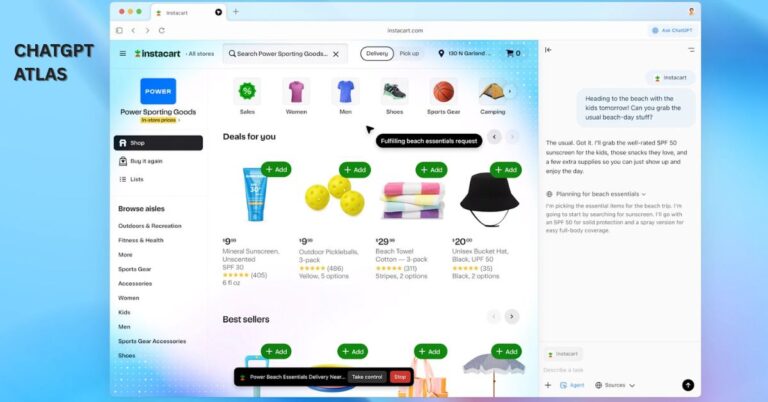ChatGPT Atlas: OpenAI’s AI browser takes on Google Chrome
OpenAI has launched ChatGPT Atlas, a MacOS AI browser built around its chatbot, positioning agentic browsing and LLM-native search as the next front in the browser wars.
ChatGPT Atlas launch: features and agent mode
Atlas reframes the browser as a conversational interface. It removes the traditional address bar and orients the experience around ChatGPT, with natural language as the primary way to navigate, retrieve, and summarize information. The initial release targets Apple’s MacOS, with OpenAI emphasizing a paid “agent mode” that can autonomously search, read, and act on the user’s behalf using the live browsing context.
Agent mode will be available to paying ChatGPT subscribers, extending OpenAI’s monetization beyond API usage and premium chatbot tiers. The company has also been building commerce and travel hooks—through partnerships with Shopify, Etsy, Expedia, and Booking.com—to let users research and transact inside conversations. OpenAI says ChatGPT is seeing hundreds of millions of weekly active users, a scale that gives Atlas a sizable funnel on day one.
Why ChatGPT Atlas matters in the AI browser era
Search behavior is fragmenting as users shift from keyword queries to conversational prompts, and Atlas formalizes that change at the browser layer.
A growing share of desktop queries already flow to large language models, indicating that LLMs are becoming a preferred interface for answers and recommendations. Meanwhile, Google is weaving generated responses deeper into Search, and Microsoft has integrated Copilot into Edge. OpenAI’s move brings the model to the front of the browser, not as an add-on but as the default mode of interaction. It also lands amid ongoing antitrust scrutiny of Google’s search dominance in the U.S., where remedies are still in flux, even as Chrome remains intact. In short, distribution, defaults, and AI assistants are converging—and Atlas pushes that convergence further.
Chrome vs Edge vs ChatGPT Atlas: the AI browser stack
The launch challenges incumbent browsers on user experience, default settings, and enterprise manageability, not just raw market share.
Chrome’s scale vs an AI-native browsing experience
Google’s Chrome is entrenched through performance, extensions, and default placement across devices. But an AI-native interface can change user habits if it reliably summarizes pages, completes tasks, and reduces clicks. The question is whether consumers and enterprises will switch to a new browser to get those gains—or expect Chrome, Edge, and Safari to match them quickly. Microsoft already offers strong AI features in Edge, and Google is accelerating Gemini-powered answers in Search and Chrome.
Distribution and default settings will drive early adoption
Atlas debuts on MacOS, limiting initial reach but targeting a high-value user base. Without iOS or Windows parity at launch, OpenAI will need partnerships and performance proof to become a daily driver. Default browser and search settings, MDM policies in enterprises, and OEM preload deals are still decisive levers. Expect Apple, Microsoft, and Google to defend their positions with tighter OS integration and admin controls.
Implications for telecoms, cloud, and the enterprise AI stack
Agentic browsing changes traffic patterns, content discovery, and the control points where value and compliance are enforced.
Network and compute impact of agentic browsing
Agent mode can generate background requests as it reads, synthesizes, and acts across sites. That means more bursty, model-driven traffic to CDNs, APIs, and media endpoints. Telcos and ISPs should prepare for higher concurrency and shorter session times as assistants fetch snippets rather than full-page loads. Edge caching strategies, DNS resolver optimization, and QoS for AI-driven sessions will matter for latency-sensitive use cases like travel bookings or customer support flows.
For cloud and CDN providers, prefetch and summarization patterns may increase small-object retrievals and API calls. Observability teams should segment “agent traffic” in logs to understand referral paths and conversion impacts when assistants mediate discovery.
Security, privacy, and compliance for AI browsers
Enterprises will need clear policies on what Atlas can access, store, and share. Browser-based agents introduce new data exfiltration vectors if they can read authenticated pages and summarize sensitive content. Zero-trust controls, CASB inspection, DLP policies, and granular SSO scopes should be validated against agent behaviors. Legal teams should review terms on data retention, training usage, and publisher compliance, including robots directives and paywalled content handling.
From SEO to AEO: optimizing for answer engines
As assistants intermediate discovery, brands must make content machine-readable and verifiable. Structured data (schema.org), well-formed metadata, and content designed for summarization improve the odds of being cited or transacted via an agent. Product catalogs, inventory, reviews, and pricing should be exposed via APIs and feeds that LLMs can safely consume with provenance. Marketing teams will need new attribution models when the assistant is the referrer and the last click disappears.
Risks and open questions for ChatGPT Atlas
Atlas will be judged on reliability, transparency, and enterprise readiness—not just novelty.
Trust, accuracy, and source attribution
Enterprises will scrutinize how Atlas cites sources, handles hallucinations, and respects paywalls. Clear indicators of confidence, links to underlying pages, and guardrails for financial, legal, or medical content will be essential. Publishers will watch how summaries affect traffic and revenue, and whether commercial arrangements emerge around content licensing or affiliate models.
Adoption barriers in consumer and enterprise environments
User habits are sticky, and many corporate environments standardize on Chrome or Edge with strict extension vetting. Executives may trial Atlas, but broad deployment will hinge on identity integration, policy controls, performance, and compatibility with enterprise tooling. If incumbents close the feature gap quickly, switching costs may outweigh benefits for mainstream users.
What businesses should do now about AI-first browsing
Treat Atlas as a signal: AI-first browsers are here, and your digital strategy should assume assistants as a primary touchpoint.
Guidance for CIOs and security leaders
Pilot Atlas in a controlled group. Validate SSO, device posture checks, logging, and DLP against agent mode. Update acceptable-use policies for AI-assisted browsing. Instrument proxies and CASBs to classify and monitor agent traffic. Run latency and reliability tests on mission-critical workflows (procurement, travel, customer care).
Guidance for product and marketing teams
Shift from SEO to answer-readiness. Implement structured data, FAQs, and product feeds optimized for LLM consumption. Offer clean APIs for inventory, availability, and pricing so agents can transact with provenance. Track how AI referrals convert versus organic search and recalibrate funnel metrics.
Guidance for telcos and ecosystem partners
Explore bundling AI browsing and assistant experiences in consumer and SMB plans, with privacy guarantees as a differentiator. Tune networks for agentic traffic patterns and offer edge compute or caching tailored to AI summarization workloads. Partner where it counts: commerce, travel, and local services integrations that assistants can reliably execute over your channels.
Bottom line: OpenAI’s ChatGPT Atlas won’t dethrone Chrome overnight, but it accelerates the shift from pages to answers and from clicks to agents. The winners will be those who adapt distribution, data, and governance for an AI-first web experience.








































